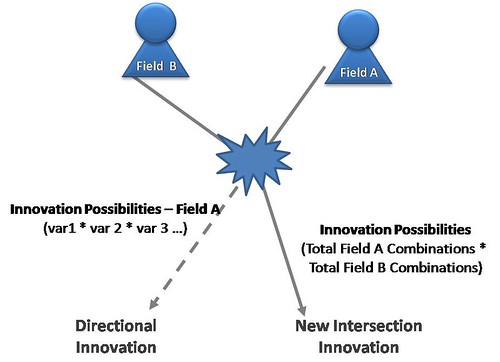Feb.08.2009
by Ed Beakley
INTERSECTIONS
Intersectional ideas are those resulting from combining concepts from multiple fields – areas of specialization gained through education and experience – as compared to those created traditionally by combing concepts within a field – noted as directional ideas. Success in intersectional idea generation is dependent upon breaking down barriers of association that would more than likely indicate a “non relationship” or at best limited context between or among fields.
This page has the following sub pages.
- I. Resilient Communities & Actionable Intelligence
- II. Training Decision Makers to the ‘Ace’ Level [Part 1]
- III. Crime and Fourth Generation Warfare – a really bad “intersection”
- IV. Bad Night for Schoolboy – And Other Stories of the Carrier
- V. Sheepdogs and White Horses
Intersections defined
Category “Five” events destablize communities and leadership’s ability to respond. They involve an enormous number and variety of “stakeholders,” make it near impossible to plan and then coordinate response in a traditional public safety Federal-State-Local sense, and by in large, have highlighted our inability to put the “unthinkable” in an actionable understanding context, much less react effectively when they occur. The Community at large seem not to grasp that the “cavalry” coming to their rescue – the leaders, emergency managers, and first responders upon which they cede their survival, will almost assuredly be among the victims of a worst case event.
Project White Horse and offerings of the authors suggest that when faced with the hyper complex catastrophic disaster, community resilience will be directly proportional to the pre-developed team capability of private citizens, private sector organizational response, designated military support, along with the available professional first responder force to act in concert. Further, PWH has focused on the need to evolve and exercise a “Team of Leaders” (ToL) across all elements and organizations of the community as an absolutely necessary precursor to co-ordinated community response and survival.
It is now offered that a model for gaining understanding, developing innovative action, and evolving the ToL capability is the “Intersection” of Frans Johansson’s The Medici Effect:
Intersectional ideas are those resulting from combining concepts from multiple fields – areas of specialization gained through education and experience – as compared to those
created traditionally by combing concepts within a field – noted as directional ideas. Success in intersectional idea generation is dependent upon breaking down barriers of association that would more than likely indicate a “non relationship” or at best limited context between or among fields.
… where different cultures, domains, and disciplines stream together toward a single point. They connect, allowing for established concepts to clash and combine, ultimately forming a multitude of new ground breaking ideas. This place, where the different fields meet, is what I call the Intersection. And the explosion of remarkable innovation that you find there is what I call the Medici Effect… (stemming from the) remarkable burst of creativity in fifteenth-century Italy.
Johansson has focused on development and value of intersectional ideas and contrasted with directional ideas, all in a conventional world context, if you will. Where we began and what we now address is - > creating intersections, intersectional ideas and effects for an environment described as hyper complex, low-probabiliity-high-impact – the unconventional – the “Cat 5.”


This page has the following sub pages.
- I. Resilient Communities & Actionable Intelligence
- II. Training decision makers to the 'Ace' level-Part 1
- II. [Part 2] Scenarios – To the ‘Ace’ Level
- II. [Part 3] Methodology – To the 'Ace' Level
- III. Crime and Fourth Generation Warfare – a really bad "intersection"
- IV. Bad Night for Schoolboy – And Other Stories of the Carrier
- V. Sheepdogs and White Horses
